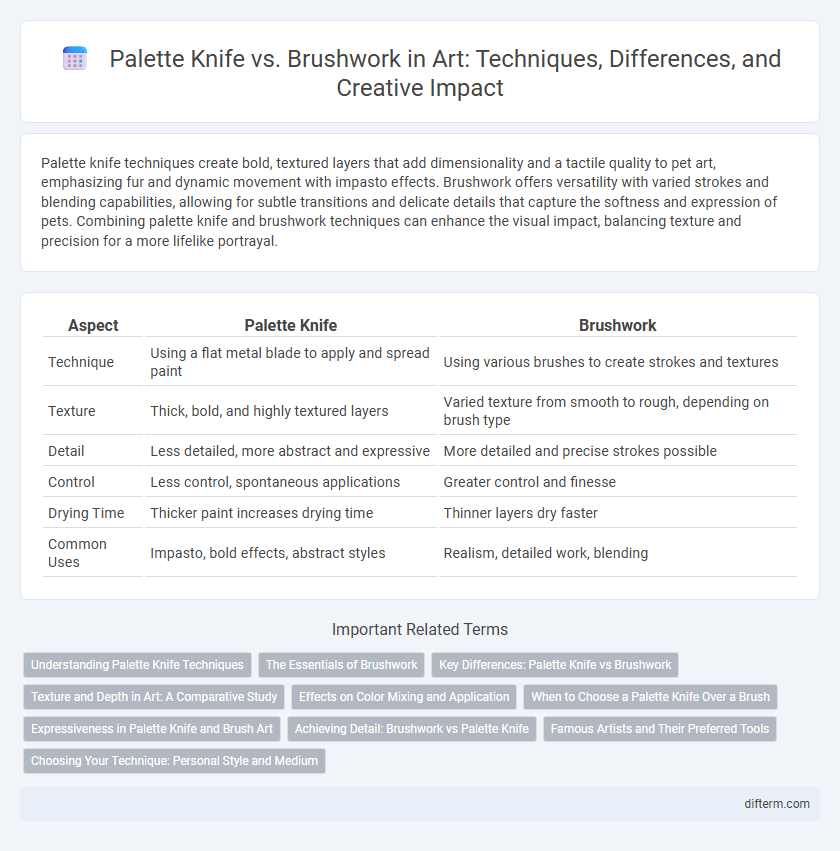Palette knife techniques create bold, textured layers that add dimensionality and a tactile quality to pet art, emphasizing fur and dynamic movement with impasto effects. Brushwork offers versatility with varied strokes and blending capabilities, allowing for subtle transitions and delicate details that capture the softness and expression of pets. Combining palette knife and brushwork techniques can enhance the visual impact, balancing texture and precision for a more lifelike portrayal.
Table of Comparison
| Aspect | Palette Knife | Brushwork |
|---|---|---|
| Technique | Using a flat metal blade to apply and spread paint | Using various brushes to create strokes and textures |
| Texture | Thick, bold, and highly textured layers | Varied texture from smooth to rough, depending on brush type |
| Detail | Less detailed, more abstract and expressive | More detailed and precise strokes possible |
| Control | Less control, spontaneous applications | Greater control and finesse |
| Drying Time | Thicker paint increases drying time | Thinner layers dry faster |
| Common Uses | Impasto, bold effects, abstract styles | Realism, detailed work, blending |
Understanding Palette Knife Techniques
Palette knife techniques create textured, bold strokes that emphasize physicality and depth, contrasting with the smooth, controlled lines achievable with brushes. The knife spreads thick layers of paint, allowing artists to build dynamic surfaces and experiment with impasto effects. Mastering palette knife skills involves manipulating pressure, angle, and paint consistency to achieve various textures and abstract qualities in a painting.
The Essentials of Brushwork
Brushwork involves the precise application of paint using various types of brushes to create texture, detail, and depth in artwork, emphasizing control and subtlety. Mastery of brushwork enables artists to achieve smooth gradients, fine lines, and varied strokes that contribute to the composition's emotional and visual impact. Unlike palette knife techniques, brushwork offers greater versatility in blending colors and refining intricate elements, making it essential for achieving realism and delicate expression in paintings.
Key Differences: Palette Knife vs Brushwork
Palette knife techniques create bold, textured strokes with thick layers of paint, emphasizing dimensionality and abstract expression. Brushwork offers a range of precision, from smooth gradients to fine details, allowing for controlled blending and subtle variations in tone and texture. The choice between palette knife and brushwork significantly affects the painting's visual impact, surface quality, and expressive style.
Texture and Depth in Art: A Comparative Study
Palette knives create bold, textured strokes that add substantial depth and dimension to paintings through thick, sculptural layers of paint. Brushwork offers more control, enabling artists to achieve fine details and subtle gradations that contribute to nuanced texture and visual depth. Combining palette knife and brush techniques can enhance the tactile quality and complexity of mixed-media artworks.
Effects on Color Mixing and Application
Palette knives create bold, textured color mixes with sharp edges and layered strokes, enhancing vibrancy and impasto effects in paintings. Brushwork allows for smoother blending and subtle gradations, facilitating controlled color transitions and fine details. The choice between palette knife and brushwork significantly influences the visual depth and tactile quality of the artwork's surface.
When to Choose a Palette Knife Over a Brush
Choose a palette knife over a brush when aiming for bold, textured strokes that create a dramatic, impasto effect in paintings. Palette knives excel at layering thick paint, producing sharp edges and a distinct sense of movement unattainable with traditional brushwork. They are ideal for abstract and expressionist art where tactile texture and spontaneous application enhance visual impact.
Expressiveness in Palette Knife and Brush Art
Palette knife techniques deliver bold, textured strokes that enhance expressiveness through dynamic layers and sharp edges, creating a vivid sense of movement and emotion. Brushwork offers nuanced control with varying pressure and stroke direction, enabling delicate transitions and subtle detail that convey depth and softness in the artwork. Together, these methods expand the expressive range by balancing texture intensity and refined precision in fine art composition.
Achieving Detail: Brushwork vs Palette Knife
Brushwork excels in achieving fine detail, allowing artists to create intricate textures and precise lines with controlled strokes. Palette knives offer a more textured, bold effect, producing thicker layers of paint that emphasize form and contrast rather than minute detail. Combining both techniques enhances a painting's dimensionality, balancing sharp detail with expressive texture.
Famous Artists and Their Preferred Tools
Picasso famously embraced palette knives to create bold textures and dynamic layers, contrasting with Van Gogh's expressive brushwork that emphasized swirling, thick strokes. Claude Monet preferred delicate brushwork to capture light's subtle nuances, whereas artists like Frank Auerbach relied on palette knives to achieve intense, sculptural effects in their paintings. The choice between palette knife and brushwork reflects distinct artistic intentions and techniques favored by these masters across art history.
Choosing Your Technique: Personal Style and Medium
Selecting between palette knife and brushwork depends on the desired texture and medium, with palette knives offering bold, impasto effects ideal for thick oils and acrylics, while brushes provide precise control suitable for detailed or layered applications. Artists often blend both techniques to enhance personal style, leveraging the knife's ability to create dynamic, abstract strokes alongside the brush's subtlety. Medium compatibility and drying time also influence the choice, as palette knives work best with slower-drying paints that allow for manipulation.
palette knife vs brushwork Infographic

 difterm.com
difterm.com